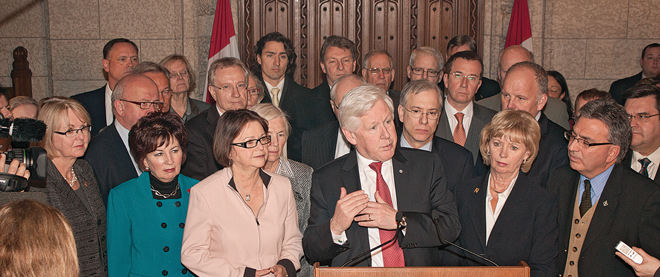The leadership look and an island’s clout
How not to look like an interim leader
Photograph by Mitchel Raphael
Share

How not to look like an interim leader
Bob Rae, the “interim” Liberal leader, has been making all the right moves to look more and more like the party’s permanent leader, and even the unofficial official leader of the Opposition. On the Hill, it’s all about positioning. The Liberal leader typically holds his Wednesday post-caucus meeting press conference outside the doors of the House of Commons. NDP interim leader Nycole Turmel holds hers outside the party’s caucus meeting room with a backdrop of coat racks. Rae often brings a few MPs along with him. Once he had the entire caucus positioned behind him, including the Liberal senators, making his numbers look hefty. Rae is also asking more questions during question period, popping up when the Liberals get their second round of questions, in addition to his guaranteed question spot in the leaders’ round. Liberal MP Hedy Fry says, “We want him to ask the questions. He does the best job.” But having Rae ask more questions also means the Prime Minister has to get up more. With the Bloc losing official party status, the PM, for the most part, just answers questions from leaders of parties officially recognized by the House and now there are just two.
Taking a development minute
When International Co-operation Minister Bev Oda travels the world meeting top country officials seeking Canada’s assistance, she is often the only woman in the room aside from her own female staff. Women on the ground can be a key to effective aid. When Oda froze new funding to Egypt after the uprising, the only exception was to help women’s groups, arguing that how women ultimately fare in Egypt will be the true test to whether democracy takes hold. Oda was appointed in August 2007 and is the longest-serving CIDA minister. Oda is hoping some of CIDA’s work will be showcased in a similar way that Canadian history got highlighted in Heritage Minutes. It’s an idea she is floating with her department. One example of such a moment could be when CIDA co-ordinated with aid groups in Afghanistan so that polio vaccinations could be administered to people in remote areas.
The NDP’s P.E.I. problem
NDP leadership hopefuls keep touting “the first NDP government” in many of their tours and debates. But if that does come true, one hurdle they will certainly face will be the Senate, since the party has no senators. All bills must be introduced in the upper chamber by a senator to become law. NDP leadership candidate Nathan Cullen says that if the Senate refused to pass their bills, “they would be making their own best case for their abolishment.” The current NDP platform calls for the abolition of the Senate. “Easy to say,” quips Stéphane Dion, the Liberal critic for democratic reform. The former Liberal leader notes that reforming the Senate would need approval from seven provinces, representing more than 50 per cent of the population. All provinces would need to be on board in order to abolish the Senate, something Dion says will be virtually impossible because of Prince Edward Island. The island will never reduce its power in the Senate; it is guaranteed four of the Senate’s 105 seats, a disproportional advantage over other provinces given its population of a mere 140,000. Also it is can have no fewer seats in the House than it does in the Senate.
In the meantime, some NDP MPs are grumbling that Stephen Harper is trying to split NDP resources as they work toward a by-election and leadership convention in Toronto. The by-election in the riding of Toronto-Danforth, called because of the death of Jack Layton, was moved from March 12 to March 19. The NDP leadership convention starts on March 23. The NDP are out in full force in Toronto-Danforth and not taking any chances with their candidate, Osgoode Hall law professor Craig Scott.